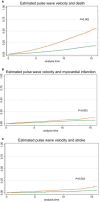Estimated Pulse Wave Velocity Is Associated With All-Cause Mortality During 8.5 Years Follow-up in Patients Undergoing Elective Coronary Angiography
- PMID: 35535599
- PMCID: PMC9238554
- DOI: 10.1161/JAHA.121.025173
Estimated Pulse Wave Velocity Is Associated With All-Cause Mortality During 8.5 Years Follow-up in Patients Undergoing Elective Coronary Angiography
Abstract
Background Estimated pulse wave velocity (ePWV) calculated by equations using age and blood pressure has been suggested as a new marker of mortality and cardiovascular risk. However, the prognostic potential of ePWV during long-term follow-up in patients with symptoms of stable angina remains unknown. Methods and Results In this study, ePWV was calculated in 25 066 patients without diabetes, previous myocardial infarction (MI), stroke, heart failure, or valvular disease (mean age 63.7±10.5 years, 58% male) with stable angina pectoris undergoing elective coronary angiography during 2003 to 2016. Multivariable Cox models were used to assess the association with incident all-cause mortality, MI, and stroke. Discrimination was assessed using Harrell´s C-index. During a median follow-up period of 8.5 years (interquartile range 5.5-11.3 years), 779 strokes, 1233 MIs, and 4112 deaths were recorded. ePWV was associated with all-cause mortality (hazard ratio [HR] per 1 m/s, 1.13; 95% CI, 1.05-1.21) and MI (HR per 1 m/s 1.23, 95% CI, 1.09-1.39) after adjusting for age, systolic blood pressure, body mass index, smoking, estimated glomerular filtration rate, Charlson Comorbidity Index score, antihypertensive treatment, statins, aspirin, and number of diseased coronary arteries. Compared with traditional risk factors, the adjusted model with ePWV was associated with a minor but likely not clinically relevant increase in discrimination for mortality, 76.63% with ePWV versus 76.56% without ePWV, P<0.05. Conclusions In patients with stable angina pectoris, ePWV was associated with all-cause mortality and MI beyond traditional risk factors. However, the added prediction of mortality was not improved to a clinically relevant extent.
Keywords: all‐cause mortality; blood pressure measurement; estimated pulse wave velocity; myocardial infarction; stroke.
Figures

Comment in
-
Estimating Is Not Measuring: The Lessons About Estimated Pulse Wave Velocity.J Am Heart Assoc. 2022 May 17;11(10):e025830. doi: 10.1161/JAHA.122.025830. Epub 2022 May 10. J Am Heart Assoc. 2022. PMID: 35535609 Free PMC article. No abstract available.
References
-
- Greve SV, Blicher MK, Blyme A, Sehestedt T, Hansen TW, Rassmusen S, Vishram JK, Ibsen H, Torp‐Pedersen C, Olsen MH. Association between albuminuria, atherosclerotic plaques, elevated pulse wave velocity, age, risk category and prognosis in apparently healthy individuals. J Hypertens. 2014;32:1034–1041. discussion 1041. doi: 10.1097/HJH.0000000000000147 - DOI - PubMed
Publication types
MeSH terms
LinkOut - more resources
Full Text Sources
Medical

